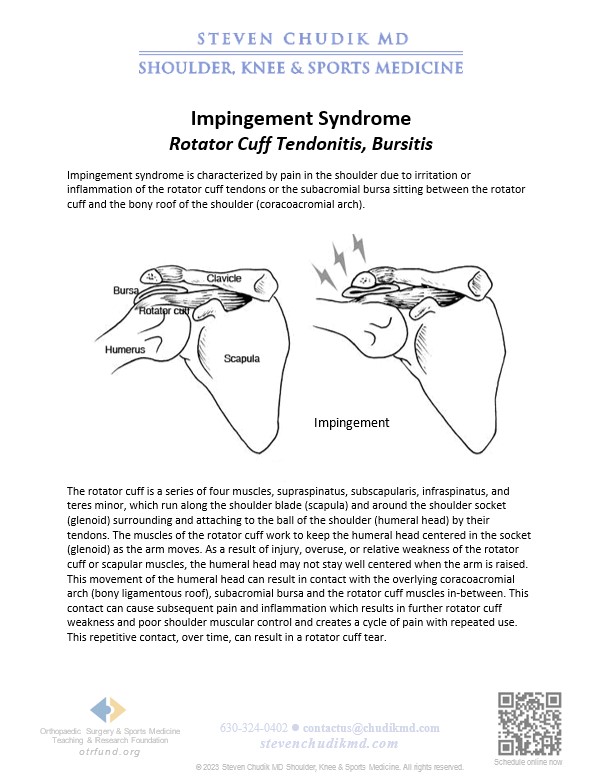 Because injuries are never planned, be prepared by bookmarking Dr. Steven Chudik's online scheduling tool today!
Because injuries are never planned, be prepared by bookmarking Dr. Steven Chudik's online scheduling tool today!
Home / Shoulder / Shoulder Surgery / Shoulder Impingement
Impingement syndrome is characterized by pain in the shoulder due to irritation or inflammation of the rotator cuff tendons or the subacromial bursa sitting between the rotator cuff and the bony roof of the shoulder (coracoacromial arch). The rotator cuff is a series of four muscles, supraspinatus, subscapularis, infraspinatus, and teres minor, which run along the shoulder blade (scapula) and around the shoulder socket (glenoid) surrounding and attaching to the ball of the shoulder (humeral head) by their tendons. The muscles of the rotator cuff work to keep the humeral head centered in the socket (glenoid) as the arm moves. As a result of injury, overuse, or relative weakness of the rotator cuff or scapular muscles, the humeral head may not stay well centered when the arm is raised. This movement of the humeral head can result in contact with the overlying coracoacromial arch (bony ligamentous roof), subacromial bursa, and the rotator cuff muscles in-between. This contact can cause subsequent pain and inflammation which results in further rotator cuff weakness and poor shoulder muscular control and creates a cycle of pain with repeated use. This repetitive contact, over time, can result in a rotator cuff tear. See more…
.
Learn More
 “Thank you Dr. Chudik for helping me get back on the field for my senior year.”
“Thank you Dr. Chudik for helping me get back on the field for my senior year.”
Dr Steven Chudik founded OTRF in 2007 to keep people active and healthy through unbiased education and research. Click to learn about OTRF’s free programs, educational opportunities and ways to participate with the nonprofit foundation.
1010 Executive Ct, Suite 250
Westmont, Illinois 60559
Phone: 630-324-0402
Fax: 630-920-2382
(New Patients)
550 W Ogden Ave
Hinsdale, IL 60521
Phone: 630-323-6116
Fax: 630-920-2382
4700 Gilbert Ave, Suite 51
Western Springs, Illinois 60558
Phone: 630-324-0402
Fax: 630-920-2382

© 2025 © 2019 Copyright Steven Chudik MD, All Rights Reserved.
